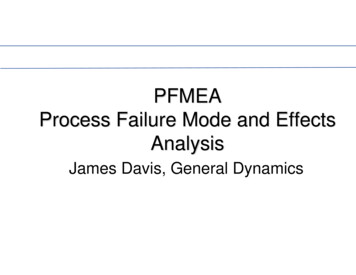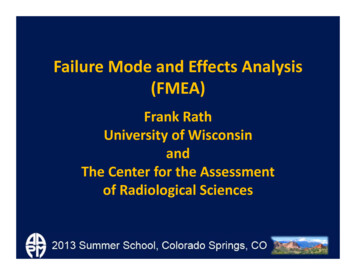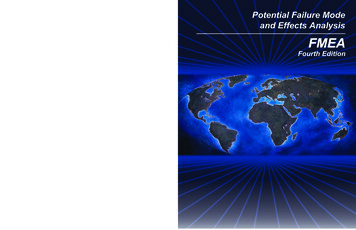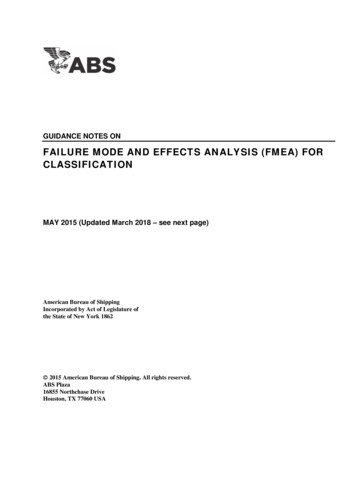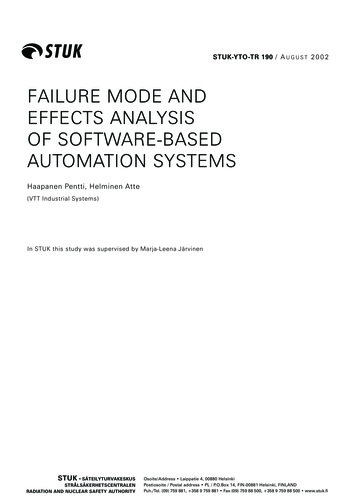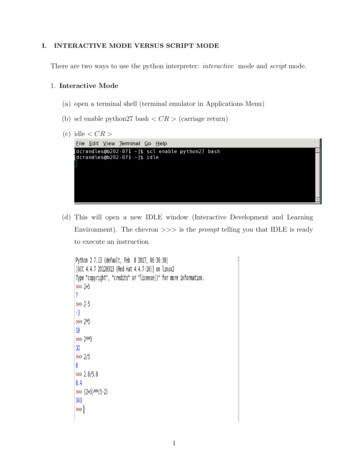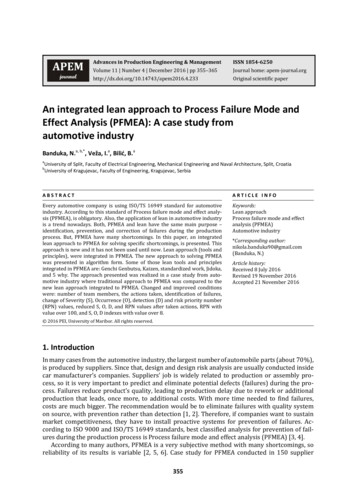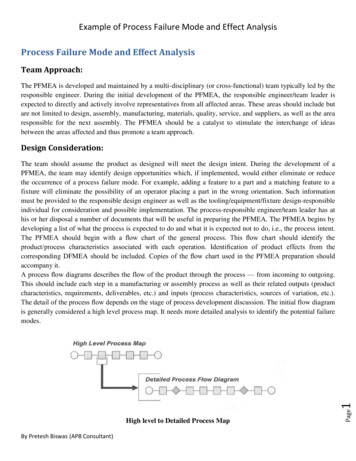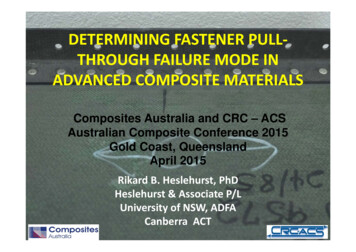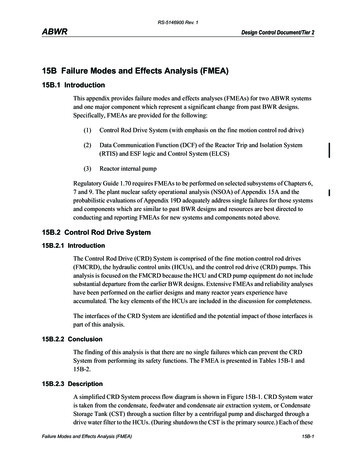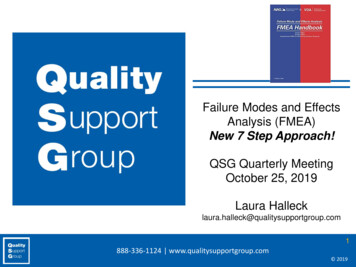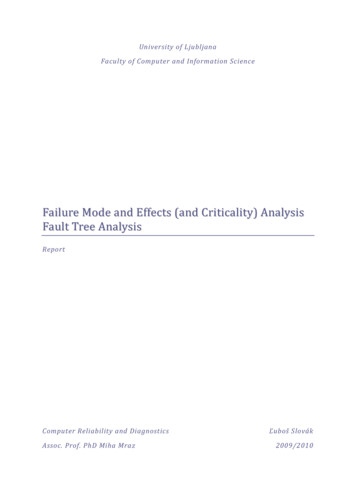
Transcription
University of LjubljanaFaculty of Computer and Information ScienceFailure Mode and Effects (and Criticality) AnalysisFault Tree AnalysisReportComputer Reliability and DiagnosticsAssoc. Prof. PhD Miha MrazĽuboš Slovák2009/2010
ContentsIntroduction. 3Motivation . 3Safety engineering . 3Techniques . 4Standards and history. 4Failure Mode and Effects Analysis .6Overview.6Types .6Procedure . 7Ranking and scales .9Example . 11Failure Mode, Effects and Criticality Analysis .12Overview.12Procedure . 13Fault Tree Analysis . 14Overview. 14Procedure . 14Examples. 15Other techniques. 16Software tools .17Conclusion . 18Bibliography . 19
IntroductionMotivationIn recent decades, the need for high-quality, reliable products have increasedenormously, and such systems are more and more often part of our everyday life. Cars,personal computers, microwave ovens and other such products are used on a dailybasis and their failures may often result in severe damage, loss of data or even loss oflives. On the other hand, in the fields with the highest demands for reliability (such asavionics, space programs, military, etc.) the products, systems and processes used arebecoming incredibly complex, what makes it very difficult to maintain their reliability.Usually, the desired reliability would be achieved by thorough testing of the product,or probabilistic reliability modeling, followed by fixes and appropriate changes to theproduct. This approach is indeed useful and may help to recognize the weak points ofthe product and improve the reliability by using techniques such as system andcomponent redundancy, N-modular redundancy, backup systems, etc. However, thesemethods can often be used only in late changes of the development process and thus itis very expensive, time-consuming, or even impossible to achieve the requiredreliability.The goal of the techniques described in this paper is to introduce the concept ofreliability and/or fault-tolerance in earlier stages of the development, particularly inthe design phase. This should result in better, fault-free (or at least fault-tolerant)designs needed for certain purposes.Safety engineeringSafety engineering is an applied science studying the reliability of critical systems andensuring that the system will behave as expected even if failures occur. Safetyengineers analyze design of a system and propose new additions to the specification orchanges to an existing system which will make the system safer. In practice, however,their role is often to prove that an existing system is safe, which may not always betrue, in which case the necessary corrections may be very expensive.
TechniquesThis paper focuses on two perhaps most commonly used methods for analyzing andmodeling potential faults in the system and their effects on it. These are: Failure modes and effects analysis (FMEA) and its extension Failure Mode,Effects, and Criticality Analysis (FMECA), and Fault tree analysis (FTA).These techniques are used to exhaustively search for potential problems in any part ofthe system, to describe their impact on the system as a whole, to plan possible actionsto reduce failures, and to evaluate the results of the actions taken. They can be usedvery early in the development cycle, even as soon as the design stage.FMEA is a bottom-up, inductive analytical method which studies the effects of singlecomponent or function failures on the system or subsystem. It is useful for exhaustivelisting of all potential initiating faults, but cannot analyze effects of multiplecoincident failures.FTA is basically a reverse (top-down, deductive) procedure and can be successfullyused to examine events of (possibly multiple) initiating faults or external events on acomplex system, but does not fit for listing all possible initiating faults.In practice, these two methods may be (and often are) used together to achieve evenbetter and more reliable designs.Standards and historyThere are many standards and quality systems incorporating FMEA/FMECA and/orFTA, often specifically designed for certain area, such as automotive and avionicindustry, power plants (especially nuclear), space programs, etc.The first standard which introduced the ideas of FMEA and FMECA was, however, aU.S. military standard MIL-STD-1629, published in 1949 as a procedure andstandardized in 1974. Even before standardization, many industries adopted thesemethods in their processes. This standard was later updated by MIL-STD-1629A. Otherindustry standards include for instance SAE J1739 or AIAG FMEA-3.
In 1960s FMEA and FMECA began to be used in NASA and its partners and since thenit was used in many NASA programs, including Apollo, Viking, Voyager and Galileo. Inthe same time, the civil avionic industry also started to use these techniques indesigning aircraft. In 1970s it spread also to automotive industry, beginning with theFord Motor Company.FTA was developed in 1962 at Bell Laboratories when evaluating the Minuteman IIntercontinental Ballistic Missile Launch Control System for the U.S. Air ForceBallistics Systems Division. Around 1966 Boeing started using FTA in the design of civilaircraft. In 1970 a change in airworthiness regulations for transport aircraft led toextensive use of FTA in civil aviation. In 1975 this method found usage also within thenuclear power industry.A general, cross-industry standard for FTA was issued by IEC under the code IEC61025, and later adopted by European Union as EN 61025. Besides that, many industrystandards for specialized uses are available, such as NRC NUREG-0492 (nuclear powerindustry) or SAE ARP4761 for civil aerospace.
Failure Mode and Effects AnalysisOverviewAs mentioned in the Introduction, Failure Mode and Effects Analysis (FMEA) is asafety engineering technique aimed at identifying and classifying potential failuremodes 1, their effects on the system and defining actions to avoid these failures. It maybe performed at either the functional or piece-part level. Ideally, it should begin asearly as the design stage of the system and continue throughout the whole life cycle.Its main use is to classify the effects of potential failure modes by severity,occurrence and detection and subsequently prioritize the actions needed tocounteract or avoid these failures. This may be done by calculating the risk prioritynumbers (RPN) for each failure mode, though it is not necessary as the nature ofcertain products requires prioritizing only one or two of the characteristics.As an essential prerequisite, an exhaustive list of potential failure modes must becompiled. While it is not possible to anticipate every possible failure mode, it is veryimportant to do the search as thorough as possible. It is necessary for the FMEA to beconducted by a team of experts with various views of the product. The designer ofthe product is essential, but as he or she often lacks the necessary critical view of theproduct, experts from other fields or even the customer should be part of the team.The output of the analysis is a FMEA Table which lists all the failure modes togetherwith possible effects on the system or subsystem categorized considering theaforementioned characteristics.TypesThere are several types of FMEA distinguished by the subject of the analysis:1 System – aims at the whole system and its functions, Design – focuses at the components or subsystems in the design stage, Process – studies the manufacturing and assembly processes,Failure mode: The manner by which a failure is observed; it generally describes the way the failureoccurs.
Service – analyses services, Software – focuses on the software functions instead of hardware.ProcedureThe procedure of FMEA is straightforward and can be divided into several distinctsteps.1. As a first step, the subject of the analysis must be defined and describedtogether with possible uses of the product, both intentional and unintentional,which are related to the subject.2. A block diagram of the subject should be created, which shows the maincomponents of the product, or process steps as blocks connected according torelations between them. Around these relations the FMEA can be developed.The FMEA Table worksheet should be also prepared in this step.3. Use the diagram to list items or functions of the subject in the worksheet.4. Identify potential Failure Modes. These should be defined as the way inwhich the subject may fail to satisfy the designed purpose. Examples of suchfailure modes may be corrosion of a component, electrical short-circuiting,deformation of the component, etc. Failures should be listed in technical termsand for each component or process step, as a failure mode in one component orprocess step may become a cause of failure mode in another.5. Determine Failure Effects – results of a failure mode on the subject asperceived by the user. These may include noise, degraded performance or eveninoperability of the product, injuries or even loss of lives. Classify the effectsaccording to their severity by giving them a severity number or category andusing a chosen scale. This is later used to prioritize the failure modes anddetermine which actions have to be taken to avoid potential faults.6. Identify all possible Failure Causes for each failure mode listed in step 4. Afailure cause is “design weakness that may result in a failure“ 2. They should bedefined in technical terms as well. Examples may include improper operatingconditions, erroneous algorithms, excessive loading, etc.2http://www.qcinspect.com/article/fmea-an overview.htm
7. The probability of the Occurrence of the causes should be ranked, again insome chosen scale.8. Examine and identify the Current Controls – mechanisms for eliminating thecauses of the failure modes or for detecting the failure before it reaches thecustomer. Henceforth, the testing, analysis, monitoring, and other techniquesof avoiding the failure causes or detecting failures used in same or similarproducts/processes should be investigated.9. The probability of Detection should be determined and ranked. This shouldreflect the likelihood of the Current Controls detecting the Failure Cause or theFailure Mode itself.10. The Risk Priority Numbers (RPN) are computed as a simple product of theSeverity, Occurrence and Detection ratings:𝑅𝑅𝑅𝑅𝑅𝑅 ���𝑆𝑆𝑆)𝑥𝑥 ���𝑂𝑂𝑂𝑂𝑂𝑂𝑂)𝑥𝑥 ���𝐷𝐷𝐷𝐷𝐷)This value may then be used to prioritize the failure modes that require acorrective action. In some areas, however, the individual ratings may be givendifferent significance.11. A list of Recommended Actions to improve the system and its design shouldbe compiled, addressing the most important potential problems according tothe previous step. These may include inspection, testing, redesigning of theproduct/process, replacing individual components, adding redundancy to thesystem or its components, scheduling preventive maintenance, etc.12. The responsibility and completion dates for these actions must be set to beable to track the improvement process.13. Point out the Actions Taken, determine the new Severity, Occurrence andDetection ratings of the subject, revise the RPN, and assess the results.Determine if the actions satisfied the expectations or whether further actionsare needed.14. Continue to update FMEA anytime the product or process changes.
Ranking and scalesThough the scales for ranking severity, probability of occurrence and probability ofdetec
FMEA. is a . bottom-up, inductive. analytical method which studies the effects of single component or function failures on the system or subsystem. It is useful for exhaustive listing of all potential initiating faults, but cannot analyze effects of multiple coincident failures. FTA. is basically a reverse .
